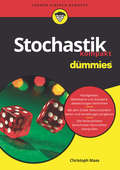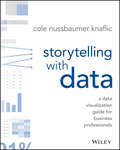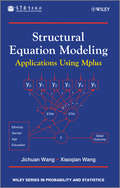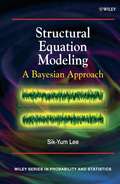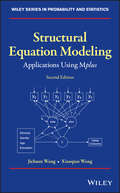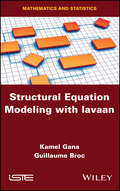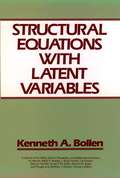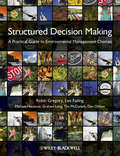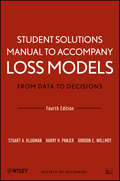- Table View
- List View
Stochastic Methods for Pension Funds (Iste Ser.)
by Pierre Devolder Jacques Janssen Raimondo MancaQuantitative finance has become these last years a extraordinary field of research and interest as well from an academic point of view as for practical applications. At the same time, pension issue is clearly a major economical and financial topic for the next decades in the context of the well-known longevity risk. Surprisingly few books are devoted to application of modern stochastic calculus to pension analysis. The aim of this book is to fill this gap and to show how recent methods of stochastic finance can be useful for to the risk management of pension funds. Methods of optimal control will be especially developed and applied to fundamental problems such as the optimal asset allocation of the fund or the cost spreading of a pension scheme. In these various problems, financial as well as demographic risks will be addressed and modelled.
Stochastic Methods for Pension Funds
by Pierre Devolder Jacques Janssen Raimondo MancaQuantitative finance has become these last years a extraordinary field of research and interest as well from an academic point of view as for practical applications. At the same time, pension issue is clearly a major economical and financial topic for the next decades in the context of the well-known longevity risk. Surprisingly few books are devoted to application of modern stochastic calculus to pension analysis. The aim of this book is to fill this gap and to show how recent methods of stochastic finance can be useful for to the risk management of pension funds. Methods of optimal control will be especially developed and applied to fundamental problems such as the optimal asset allocation of the fund or the cost spreading of a pension scheme. In these various problems, financial as well as demographic risks will be addressed and modelled.
Stochastic Numerical Methods: An Introduction for Students and Scientists
by Raúl Toral Pere ColetStochastic Numerical Methods introduces at Master level the numerical methods that use probability or stochastic concepts to analyze random processes. The book aims at being rather general and is addressed at students of natural sciences (Physics, Chemistry, Mathematics, Biology, etc.) and Engineering, but also social sciences (Economy, Sociology, etc.) where some of the techniques have been used recently to numerically simulate different agent-based models. Examples included in the book range from phase-transitions and critical phenomena, including details of data analysis (extraction of critical exponents, finite-size effects, etc.), to population dynamics, interfacial growth, chemical reactions, etc. Program listings are integrated in the discussion of numerical algorithms to facilitate their understanding. From the contents: Review of Probability Concepts Monte Carlo Integration Generation of Uniform and Non-uniform Random Numbers: Non-correlated Values Dynamical Methods Applications to Statistical Mechanics Introduction to Stochastic Processes Numerical Simulation of Ordinary and Partial Stochastic Differential Equations Introduction to Master Equations Numerical Simulations of Master Equations Hybrid Monte Carlo Generation of n-Dimensional Correlated Gaussian Variables Collective Algorithms for Spin Systems Histogram Extrapolation Multicanonical Simulations
Stochastic Numerical Methods: An Introduction for Students and Scientists
by Raúl Toral Pere ColetStochastic Numerical Methods introduces at Master level the numerical methods that use probability or stochastic concepts to analyze random processes. The book aims at being rather general and is addressed at students of natural sciences (Physics, Chemistry, Mathematics, Biology, etc.) and Engineering, but also social sciences (Economy, Sociology, etc.) where some of the techniques have been used recently to numerically simulate different agent-based models. Examples included in the book range from phase-transitions and critical phenomena, including details of data analysis (extraction of critical exponents, finite-size effects, etc.), to population dynamics, interfacial growth, chemical reactions, etc. Program listings are integrated in the discussion of numerical algorithms to facilitate their understanding. From the contents: Review of Probability Concepts Monte Carlo Integration Generation of Uniform and Non-uniform Random Numbers: Non-correlated Values Dynamical Methods Applications to Statistical Mechanics Introduction to Stochastic Processes Numerical Simulation of Ordinary and Partial Stochastic Differential Equations Introduction to Master Equations Numerical Simulations of Master Equations Hybrid Monte Carlo Generation of n-Dimensional Correlated Gaussian Variables Collective Algorithms for Spin Systems Histogram Extrapolation Multicanonical Simulations
Stochastic Processes for Insurance and Finance (Wiley Series in Probability and Statistics #505)
by Tomasz Rolski Hanspeter Schmidli V. Schmidt Jozef L. TeugelsStochastic Processes for Insurance and Finance offers a thorough yet accessible reference for researchers and practitioners of insurance mathematics. Building on recent and rapid developments in applied probability, the authors describe in general terms models based on Markov processes, martingales and various types of point processes. Discussing frequently asked insurance questions, the authors present a coherent overview of the subject and specifically address: · The principal concepts from insurance and finance · Practical examples with real life data · Numerical and algorithmic procedures essential for modern insurance practices Assuming competence in probability calculus, this book will provide a fairly rigorous treatment of insurance risk theory recommended for researchers and students interested in applied probability as well as practitioners of actuarial sciences. Wiley Series in Probability and Statistics
Stochastic Risk Analysis and Management
by Boris HarlamovThe author investigates the Cramer –Lundberg model, collecting the most interesting theorems and methods, which estimate probability of default for a company of insurance business. These offer different kinds of approximate values for probability of default on the base of normal and diffusion approach and some special asymptotic.
Stochastic Risk Analysis and Management
by Boris HarlamovThe author investigates the Cramer –Lundberg model, collecting the most interesting theorems and methods, which estimate probability of default for a company of insurance business. These offer different kinds of approximate values for probability of default on the base of normal and diffusion approach and some special asymptotic.
Stochastic Simulation (Wiley Series in Probability and Statistics #316)
by Brian D. RipleyWILEY-INTERSCIENCE PAPERBACK SERIES The Wiley-Interscience Paperback Series consists of selected books that have been made more accessible to consumers in an effort to increase global appeal and general circulation. With these new unabridged softcover volumes, Wiley hopes to extend the lives of these works by making them available to future generations of statisticians, mathematicians, and scientists. ". . .this is a very competently written and useful addition to the statistical literature; a book every statistician should look at and that many should study!" —Short Book Reviews, International Statistical Institute ". . .reading this book was an enjoyable learning experience. The suggestions and recommendations on the methods [make] this book an excellent reference for anyone interested in simulation. With its compact structure and good coverage of material, it [is] an excellent textbook for a simulation course." —Technometrics ". . .this work is an excellent comprehensive guide to simulation methods, written by a very competent author. It is especially recommended for those users of simulation methods who want more than a 'cook book'. " —Mathematics Abstracts This book is a comprehensive guide to simulation methods with explicit recommendations of methods and algorithms. It covers both the technical aspects of the subject, such as the generation of random numbers, non-uniform random variates and stochastic processes, and the use of simulation. Supported by the relevant mathematical theory, the text contains a great deal of unpublished research material, including coverage of the analysis of shift-register generators, sensitivity analysis of normal variate generators, analysis of simulation output, and more.
Stochastic Structural Dynamics: Application of Finite Element Methods
by Cho W. ToOne of the first books to provide in-depth and systematic application of finite element methods to the field of stochastic structural dynamics The parallel developments of the Finite Element Methods in the 1950’s and the engineering applications of stochastic processes in the 1940’s provided a combined numerical analysis tool for the studies of dynamics of structures and structural systems under random loadings. In the open literature, there are books on statistical dynamics of structures and books on structural dynamics with chapters dealing with random response analysis. However, a systematic treatment of stochastic structural dynamics applying the finite element methods seems to be lacking. Aimed at advanced and specialist levels, the author presents and illustrates analytical and direct integration methods for analyzing the statistics of the response of structures to stochastic loads. The analysis methods are based on structural models represented via the Finite Element Method. In addition to linear problems the text also addresses nonlinear problems and non-stationary random excitation with systems having large spatially stochastic property variations. A systematic treatment of stochastic structural dynamics applying the finite element methods Highly illustrated throughout and aimed at advanced and specialist levels, it focuses on computational aspects instead of theory Emphasizes results mainly in the time domain with limited contents in the time-frequency domain Presents and illustrates direction integration methods for analyzing the statistics of the response of linear and nonlinear structures to stochastic loads Under Author Information - one change of word to existing text: He is a Fellow of the American Society of Mechanical Engineers (ASME)........
Stochastic Structural Dynamics: Application of Finite Element Methods
by Cho W. ToOne of the first books to provide in-depth and systematic application of finite element methods to the field of stochastic structural dynamics The parallel developments of the Finite Element Methods in the 1950’s and the engineering applications of stochastic processes in the 1940’s provided a combined numerical analysis tool for the studies of dynamics of structures and structural systems under random loadings. In the open literature, there are books on statistical dynamics of structures and books on structural dynamics with chapters dealing with random response analysis. However, a systematic treatment of stochastic structural dynamics applying the finite element methods seems to be lacking. Aimed at advanced and specialist levels, the author presents and illustrates analytical and direct integration methods for analyzing the statistics of the response of structures to stochastic loads. The analysis methods are based on structural models represented via the Finite Element Method. In addition to linear problems the text also addresses nonlinear problems and non-stationary random excitation with systems having large spatially stochastic property variations. A systematic treatment of stochastic structural dynamics applying the finite element methods Highly illustrated throughout and aimed at advanced and specialist levels, it focuses on computational aspects instead of theory Emphasizes results mainly in the time domain with limited contents in the time-frequency domain Presents and illustrates direction integration methods for analyzing the statistics of the response of linear and nonlinear structures to stochastic loads Under Author Information - one change of word to existing text: He is a Fellow of the American Society of Mechanical Engineers (ASME)........
Stochastik kompakt für Dummies (Für Dummies)
by Christoph MaasDie Stochastik kommt manchmal zu Aussagen, die der Intuition widersprechen. Dann wieder erscheinen zwei mathematische Modelle in einer Anwendungssituation gleich plausibel, führen aber zu ganz unterschiedlichen Ergebnissen. Was nun? Dieses Buch ermöglicht Ihnen den Einstieg in typische stochastische Fragestellungen. Abschnitte "Das steckt dahinter" und "Darauf kommt es an" in jedem Kapitel arbeiten den Kern des Ganzen heraus. Rechenverfahren werden so vorgestellt, dass Sie sie sofort einsetzen können. Viele Beispiele aus verschiedenen Anwendungsgebieten machen deutlich, wofür Sie Stochastik brauchen.
Storytelling with Data: A Data Visualization Guide for Business Professionals
by Cole Nussbaumer KnaflicDon't simply show your data—tell a story with it! Storytelling with Data teaches you the fundamentals of data visualization and how to communicate effectively with data. You'll discover the power of storytelling and the way to make data a pivotal point in your story. The lessons in this illuminative text are grounded in theory, but made accessible through numerous real-world examples—ready for immediate application to your next graph or presentation. Storytelling is not an inherent skill, especially when it comes to data visualization, and the tools at our disposal don't make it any easier. This book demonstrates how to go beyond conventional tools to reach the root of your data, and how to use your data to create an engaging, informative, compelling story. Specifically, you'll learn how to: Understand the importance of context and audience Determine the appropriate type of graph for your situation Recognize and eliminate the clutter clouding your information Direct your audience's attention to the most important parts of your data Think like a designer and utilize concepts of design in data visualization Leverage the power of storytelling to help your message resonate with your audience Together, the lessons in this book will help you turn your data into high impact visual stories that stick with your audience. Rid your world of ineffective graphs, one exploding 3D pie chart at a time. There is a story in your data—Storytelling with Data will give you the skills and power to tell it!
Storytelling with Data: A Data Visualization Guide for Business Professionals
by Cole Nussbaumer KnaflicDon't simply show your data—tell a story with it! Storytelling with Data teaches you the fundamentals of data visualization and how to communicate effectively with data. You'll discover the power of storytelling and the way to make data a pivotal point in your story. The lessons in this illuminative text are grounded in theory, but made accessible through numerous real-world examples—ready for immediate application to your next graph or presentation. Storytelling is not an inherent skill, especially when it comes to data visualization, and the tools at our disposal don't make it any easier. This book demonstrates how to go beyond conventional tools to reach the root of your data, and how to use your data to create an engaging, informative, compelling story. Specifically, you'll learn how to: Understand the importance of context and audience Determine the appropriate type of graph for your situation Recognize and eliminate the clutter clouding your information Direct your audience's attention to the most important parts of your data Think like a designer and utilize concepts of design in data visualization Leverage the power of storytelling to help your message resonate with your audience Together, the lessons in this book will help you turn your data into high impact visual stories that stick with your audience. Rid your world of ineffective graphs, one exploding 3D pie chart at a time. There is a story in your data—Storytelling with Data will give you the skills and power to tell it!
Structural Equation Modeling: Applications Using Mplus (Wiley Series in Probability and Statistics #953)
by Jichuan Wang Xiaoqian WangA reference guide for applications of SEM using Mplus Structural Equation Modeling: Applications Using Mplus is intended as both a teaching resource and a reference guide. Written in non-mathematical terms, this book focuses on the conceptual and practical aspects of Structural Equation Modeling (SEM). Basic concepts and examples of various SEM models are demonstrated along with recently developed advanced methods, such as mixture modeling and model-based power analysis and sample size estimate for SEM. The statistical modeling program, Mplus, is also featured and provides researchers with a flexible tool to analyze their data with an easy-to-use interface and graphical displays of data and analysis results. Key features: Presents a useful reference guide for applications of SEM whilst systematically demonstrating various advanced SEM models, such as multi-group and mixture models using Mplus. Discusses and demonstrates various SEM models using both cross-sectional and longitudinal data with both continuous and categorical outcomes. Provides step-by-step instructions of model specification and estimation, as well as detail interpretation of Mplus results. Explores different methods for sample size estimate and statistical power analysis for SEM. By following the examples provided in this book, readers will be able to build their own SEM models using Mplus. Teachers, graduate students, and researchers in social sciences and health studies will also benefit from this book.
Structural Equation Modeling: Applications Using Mplus (Wiley Series in Probability and Statistics)
by Jichuan Wang Xiaoqian WangA reference guide for applications of SEM using Mplus Structural Equation Modeling: Applications Using Mplus is intended as both a teaching resource and a reference guide. Written in non-mathematical terms, this book focuses on the conceptual and practical aspects of Structural Equation Modeling (SEM). Basic concepts and examples of various SEM models are demonstrated along with recently developed advanced methods, such as mixture modeling and model-based power analysis and sample size estimate for SEM. The statistical modeling program, Mplus, is also featured and provides researchers with a flexible tool to analyze their data with an easy-to-use interface and graphical displays of data and analysis results. Key features: Presents a useful reference guide for applications of SEM whilst systematically demonstrating various advanced SEM models, such as multi-group and mixture models using Mplus. Discusses and demonstrates various SEM models using both cross-sectional and longitudinal data with both continuous and categorical outcomes. Provides step-by-step instructions of model specification and estimation, as well as detail interpretation of Mplus results. Explores different methods for sample size estimate and statistical power analysis for SEM. By following the examples provided in this book, readers will be able to build their own SEM models using Mplus. Teachers, graduate students, and researchers in social sciences and health studies will also benefit from this book.
Structural Equation Modeling: A Bayesian Approach (Wiley Series in Probability and Statistics #711)
by Sik-Yum Lee***Winner of the 2008 Ziegel Prize for outstanding new book of the year*** Structural equation modeling (SEM) is a powerful multivariate method allowing the evaluation of a series of simultaneous hypotheses about the impacts of latent and manifest variables on other variables, taking measurement errors into account. As SEMs have grown in popularity in recent years, new models and statistical methods have been developed for more accurate analysis of more complex data. A Bayesian approach to SEMs allows the use of prior information resulting in improved parameter estimates, latent variable estimates, and statistics for model comparison, as well as offering more reliable results for smaller samples. Structural Equation Modeling introduces the Bayesian approach to SEMs, including the selection of prior distributions and data augmentation, and offers an overview of the subject’s recent advances. Demonstrates how to utilize powerful statistical computing tools, including the Gibbs sampler, the Metropolis-Hasting algorithm, bridge sampling and path sampling to obtain the Bayesian results. Discusses the Bayes factor and Deviance Information Criterion (DIC) for model comparison. Includes coverage of complex models, including SEMs with ordered categorical variables, and dichotomous variables, nonlinear SEMs, two-level SEMs, multisample SEMs, mixtures of SEMs, SEMs with missing data, SEMs with variables from an exponential family of distributions, and some of their combinations. Illustrates the methodology through simulation studies and examples with real data from business management, education, psychology, public health and sociology. Demonstrates the application of the freely available software WinBUGS via a supplementary website featuring computer code and data sets. Structural Equation Modeling: A Bayesian Approach is a multi-disciplinary text ideal for researchers and students in many areas, including: statistics, biostatistics, business, education, medicine, psychology, public health and social science.
Structural Equation Modeling: Applications Using Mplus (Wiley Series in Probability and Statistics)
by Jichuan Wang Xiaoqian WangPresents a useful guide for applications of SEM whilst systematically demonstrating various SEM models using Mplus Focusing on the conceptual and practical aspects of Structural Equation Modeling (SEM), this book demonstrates basic concepts and examples of various SEM models, along with updates on many advanced methods, including confirmatory factor analysis (CFA) with categorical items, bifactor model, Bayesian CFA model, item response theory (IRT) model, graded response model (GRM), multiple imputation (MI) of missing values, plausible values of latent variables, moderated mediation model, Bayesian SEM, latent growth modeling (LGM) with individually varying times of observations, dynamic structural equation modeling (DSEM), residual dynamic structural equation modeling (RDSEM), testing measurement invariance of instrument with categorical variables, longitudinal latent class analysis (LLCA), latent transition analysis (LTA), growth mixture modeling (GMM) with covariates and distal outcome, manual implementation of the BCH method and the three-step method for mixture modeling, Monte Carlo simulation power analysis for various SEM models, and estimate sample size for latent class analysis (LCA) model. The statistical modeling program Mplus Version 8.2 is featured with all models updated. It provides researchers with a flexible tool that allows them to analyze data with an easy-to-use interface and graphical displays of data and analysis results. Intended as both a teaching resource and a reference guide, and written in non-mathematical terms, Structural Equation Modeling: Applications Using Mplus, 2nd edition provides step-by-step instructions of model specification, estimation, evaluation, and modification. Chapters cover: Confirmatory Factor Analysis (CFA); Structural Equation Models (SEM); SEM for Longitudinal Data; Multi-Group Models; Mixture Models; and Power Analysis and Sample Size Estimate for SEM. Presents a useful reference guide for applications of SEM while systematically demonstrating various advanced SEM models Discusses and demonstrates various SEM models using both cross-sectional and longitudinal data with both continuous and categorical outcomes Provides step-by-step instructions of model specification and estimation, as well as detailed interpretation of Mplus results using real data sets Introduces different methods for sample size estimate and statistical power analysis for SEM Structural Equation Modeling is an excellent book for researchers and graduate students of SEM who want to understand the theory and learn how to build their own SEM models using Mplus.
Structural Equation Modeling: Applications Using Mplus (Wiley Series in Probability and Statistics #9)
by Jichuan Wang Xiaoqian WangPresents a useful guide for applications of SEM whilst systematically demonstrating various SEM models using Mplus Focusing on the conceptual and practical aspects of Structural Equation Modeling (SEM), this book demonstrates basic concepts and examples of various SEM models, along with updates on many advanced methods, including confirmatory factor analysis (CFA) with categorical items, bifactor model, Bayesian CFA model, item response theory (IRT) model, graded response model (GRM), multiple imputation (MI) of missing values, plausible values of latent variables, moderated mediation model, Bayesian SEM, latent growth modeling (LGM) with individually varying times of observations, dynamic structural equation modeling (DSEM), residual dynamic structural equation modeling (RDSEM), testing measurement invariance of instrument with categorical variables, longitudinal latent class analysis (LLCA), latent transition analysis (LTA), growth mixture modeling (GMM) with covariates and distal outcome, manual implementation of the BCH method and the three-step method for mixture modeling, Monte Carlo simulation power analysis for various SEM models, and estimate sample size for latent class analysis (LCA) model. The statistical modeling program Mplus Version 8.2 is featured with all models updated. It provides researchers with a flexible tool that allows them to analyze data with an easy-to-use interface and graphical displays of data and analysis results. Intended as both a teaching resource and a reference guide, and written in non-mathematical terms, Structural Equation Modeling: Applications Using Mplus, 2nd edition provides step-by-step instructions of model specification, estimation, evaluation, and modification. Chapters cover: Confirmatory Factor Analysis (CFA); Structural Equation Models (SEM); SEM for Longitudinal Data; Multi-Group Models; Mixture Models; and Power Analysis and Sample Size Estimate for SEM. Presents a useful reference guide for applications of SEM while systematically demonstrating various advanced SEM models Discusses and demonstrates various SEM models using both cross-sectional and longitudinal data with both continuous and categorical outcomes Provides step-by-step instructions of model specification and estimation, as well as detailed interpretation of Mplus results using real data sets Introduces different methods for sample size estimate and statistical power analysis for SEM Structural Equation Modeling is an excellent book for researchers and graduate students of SEM who want to understand the theory and learn how to build their own SEM models using Mplus.
Structural Equation Modeling with lavaan
by Kamel Gana Guillaume BrocThis book presents an introduction to structural equation modeling (SEM) and facilitates the access of students and researchers in various scientific fields to this powerful statistical tool. It offers a didactic initiation to SEM as well as to the open-source software, lavaan, and the rich and comprehensive technical features it offers. Structural Equation Modeling with lavaan thus helps the reader to gain autonomy in the use of SEM to test path models and dyadic models, perform confirmatory factor analyses and estimate more complex models such as general structural models with latent variables and latent growth models. SEM is approached both from the point of view of its process (i.e. the different stages of its use) and from the point of view of its product (i.e. the results it generates and their reading).
Structural Equation Modeling with lavaan
by Kamel Gana Guillaume BrocThis book presents an introduction to structural equation modeling (SEM) and facilitates the access of students and researchers in various scientific fields to this powerful statistical tool. It offers a didactic initiation to SEM as well as to the open-source software, lavaan, and the rich and comprehensive technical features it offers. Structural Equation Modeling with lavaan thus helps the reader to gain autonomy in the use of SEM to test path models and dyadic models, perform confirmatory factor analyses and estimate more complex models such as general structural models with latent variables and latent growth models. SEM is approached both from the point of view of its process (i.e. the different stages of its use) and from the point of view of its product (i.e. the results it generates and their reading).
Structural Equations with Latent Variables (Wiley Series in Probability and Statistics #210)
by Kenneth A. BollenAnalysis of Ordinal Categorical Data Alan Agresti Statistical Science Now has its first coordinated manual of methods for analyzing ordered categorical data. This book discusses specialized models that, unlike standard methods underlying nominal categorical data, efficiently use the information on ordering. It begins with an introduction to basic descriptive and inferential methods for categorical data, and then gives thorough coverage of the most current developments, such as loglinear and logit models for ordinal data. Special emphasis is placed on interpretation and application of methods and contains an integrated comparison of the available strategies for analyzing ordinal data. This is a case study work with illuminating examples taken from across the wide spectrum of ordinal categorical applications. 1984 (0 471-89055-3) 287 pp. Regression Diagnostics Identifying Influential Data and Sources of Collinearity David A. Belsley, Edwin Kuh and Roy E. Welsch This book provides the practicing statistician and econometrician with new tools for assessing the quality and reliability of regression estimates. Diagnostic techniques are developed that aid in the systematic location of data points that are either unusual or inordinately influential; measure the presence and intensity of collinear relations among the regression data and help to identify the variables involved in each; and pinpoint the estimated coefficients that are potentially most adversely affected. The primary emphasis of these contributions is on diagnostics, but suggestions for remedial action are given and illustrated. 1980 (0 471-05856-4) 292 pp. Applied Regression Analysis Second Edition Norman Draper and Harry Smith Featuring a significant expansion of material reflecting recent advances, here is a complete and up-to-date introduction to the fundamentals of regression analysis, focusing on understanding the latest concepts and applications of these methods. The authors thoroughly explore the fitting and checking of both linear and nonlinear regression models, using small or large data sets and pocket or high-speed computing equipment. Features added to this Second Edition include the practical implications of linear regression; the Durbin-Watson test for serial correlation; families of transformations; inverse, ridge, latent root and robust regression; and nonlinear growth models. Includes many new exercises and worked examples. 1981 (0 471-02995-5) 709 pp.
Structural Equations with Latent Variables (Wiley Series in Probability and Statistics #210)
by Kenneth A. BollenAnalysis of Ordinal Categorical Data Alan Agresti Statistical Science Now has its first coordinated manual of methods for analyzing ordered categorical data. This book discusses specialized models that, unlike standard methods underlying nominal categorical data, efficiently use the information on ordering. It begins with an introduction to basic descriptive and inferential methods for categorical data, and then gives thorough coverage of the most current developments, such as loglinear and logit models for ordinal data. Special emphasis is placed on interpretation and application of methods and contains an integrated comparison of the available strategies for analyzing ordinal data. This is a case study work with illuminating examples taken from across the wide spectrum of ordinal categorical applications. 1984 (0 471-89055-3) 287 pp. Regression Diagnostics Identifying Influential Data and Sources of Collinearity David A. Belsley, Edwin Kuh and Roy E. Welsch This book provides the practicing statistician and econometrician with new tools for assessing the quality and reliability of regression estimates. Diagnostic techniques are developed that aid in the systematic location of data points that are either unusual or inordinately influential; measure the presence and intensity of collinear relations among the regression data and help to identify the variables involved in each; and pinpoint the estimated coefficients that are potentially most adversely affected. The primary emphasis of these contributions is on diagnostics, but suggestions for remedial action are given and illustrated. 1980 (0 471-05856-4) 292 pp. Applied Regression Analysis Second Edition Norman Draper and Harry Smith Featuring a significant expansion of material reflecting recent advances, here is a complete and up-to-date introduction to the fundamentals of regression analysis, focusing on understanding the latest concepts and applications of these methods. The authors thoroughly explore the fitting and checking of both linear and nonlinear regression models, using small or large data sets and pocket or high-speed computing equipment. Features added to this Second Edition include the practical implications of linear regression; the Durbin-Watson test for serial correlation; families of transformations; inverse, ridge, latent root and robust regression; and nonlinear growth models. Includes many new exercises and worked examples. 1981 (0 471-02995-5) 709 pp.
Structured Decision Making: A Practical Guide to Environmental Management Choices
by Robin Gregory Lee Failing Michael Harstone Graham Long Tim McDaniels Dan OhlsonThis book outlines the creative process of making environmental management decisions using the approach called Structured Decision Making. It is a short introductory guide to this popular form of decision making and is aimed at environmental managers and scientists. This is a distinctly pragmatic label given to ways for helping individuals and groups think through tough multidimensional choices characterized by uncertain science, diverse stakeholders, and difficult tradeoffs. This is the everyday reality of environmental management, yet many important decisions currently are made on an ad hoc basis that lacks a solid value-based foundation, ignores key information, and results in selection of an inferior alternative. Making progress – in a way that is rigorous, inclusive, defensible and transparent – requires combining analytical methods drawn from the decision sciences and applied ecology with deliberative insights from cognitive psychology, facilitation and negotiation. The authors review key methods and discuss case-study examples based in their experiences in communities, boardrooms, and stakeholder meetings. The goal of this book is to lay out a compelling guide that will change how you think about making environmental decisions. Visit www.wiley.com/go/gregory/sdm to access the figures and tables from the book.
Structured Decision Making: A Practical Guide to Environmental Management Choices
by Robin Gregory Lee Failing Michael Harstone Graham Long Tim McDaniels Dan OhlsonThis book outlines the creative process of making environmental management decisions using the approach called Structured Decision Making. It is a short introductory guide to this popular form of decision making and is aimed at environmental managers and scientists. This is a distinctly pragmatic label given to ways for helping individuals and groups think through tough multidimensional choices characterized by uncertain science, diverse stakeholders, and difficult tradeoffs. This is the everyday reality of environmental management, yet many important decisions currently are made on an ad hoc basis that lacks a solid value-based foundation, ignores key information, and results in selection of an inferior alternative. Making progress – in a way that is rigorous, inclusive, defensible and transparent – requires combining analytical methods drawn from the decision sciences and applied ecology with deliberative insights from cognitive psychology, facilitation and negotiation. The authors review key methods and discuss case-study examples based in their experiences in communities, boardrooms, and stakeholder meetings. The goal of this book is to lay out a compelling guide that will change how you think about making environmental decisions. Visit www.wiley.com/go/gregory/sdm to access the figures and tables from the book.
Student Solutions Manual to Accompany Loss Models: From Data To Decisions (Wiley Series in Probability and Statistics #977)
by Stuart A. Klugman Harry H. Panjer Gordon E. WillmotStudent Solutions Manual to Accompany Loss Models: From Data to Decisions, Fourth Edition. This volume is organised around the principle that much of actuarial science consists of the construction and analysis of mathematical models which describe the process by which funds flow into and out of an insurance system.







